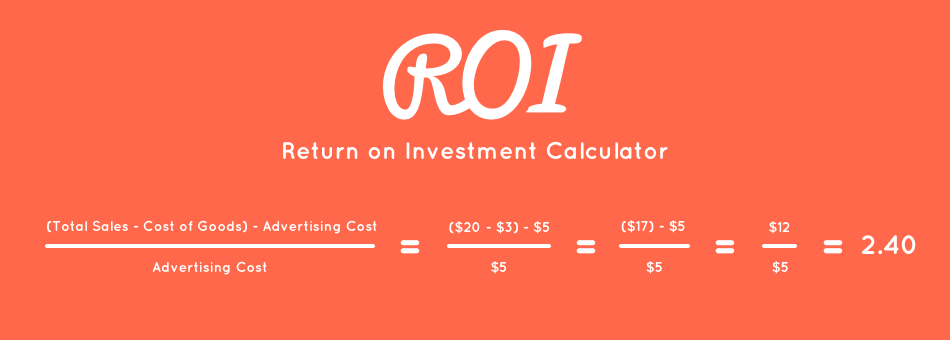ROI is the acronym for Return On Investment. This indicator enables us to measure an investment performance. For this calculation, we have to divide the profits obtained between the investment made. The result is shown as a percentage or rate:
For example:
If you’ve invested $100 and you get $150, your ROI is 50%, or 1.5:1.
Expressing ROI like this makes it possible to share different investments.
How to calculate ROI?

ROI is the proportion between the net profit and the investment cost. One of the easiest ways to express it is this:
ROI = (Increase of utilities – Investment made) / Investment made
For instance, if every US$10 spent on marketing a company is getting US$50 additional profit, the sums will be the following:
ROI = (50 – 10) / 10 x 100
ROI = 4 x 100
ROI = 400% (4:1)
What is a good ROI in digital marketing?
An acceptable ROI level for a marketing campaign goes from 4:1 to 6:1. Any value below these tells of an important need for improvement. Some particularly successful campaigns might reach a 10:1 ROI, though that is really exceptional.
Importance of ROI in digital marketing
In order for a marketing strategy to work properly, you have to be able to measure its effectiveness very accurately, as the final purpose is to have that investment reflected on an actual profit increase of your company.
Here is where ROI comes into play. It’s a tool which will provide objective information about the investment made / obtained profits relationship. For example:
- Investment A: $15,270 Net profits of A: $40,200
- Investment B: $10,500 Net profits of B: $35,000
At first sight, investment A had a higher profit in absolute terms, so we might be inclined to prefer this type of investment; but taking into account that both investments were different, our conclusion might be different as well. Using a simple formula to calculate the ROI of the example above, we’ll reach these conclusions:
- ROI A: (40,200-15,270) / 15,270 = 1.63 x 100 = 163%
- ROI B: (35,000-10,500) / 10,500 = 2.33 x 100 = 233%
Now it’s pretty clear that investment B is much more profitable than A, and we can see exactly in what proportions. In this way, you can make the right decision regarding your future marketing strategies, and thus, making the most of your investment.
You may like: Importance of ROI: Why it matters for all businesses
What are the benefits of measuring ROI?
Measuring the return on investment of your marketing strategy has three main benefits:
- Justifying your investment: If you’re investing money in digital marketing, it’s only natural that you want to see clearly if it’s worthy.
- Keeping the best ideas for yourself: A marketing campaign is rarely static: usually more than two strategies are tested along many months. Monitoring ROI lets you identify the most effective channels and contents, so as to concentrate your efforts on them.
- Holding the creative pros down-to-earth: Creativeness is very important in marketing, but no more than results are. Having the expected ROI into account promotes your creative department to focus on effective solutions.
Who measures ROI?
Usually it’s a marketing specialist who holds responsibility for calculating the obtained ROI, assisted by a finance analyst or accountant.
In very large companies, it might be necessary to outsource this to some external agency which counts on tools for data analysis at greater scale.
Keep learning
You can find many online resources related to this performance indicator. Below there are some of the best we’ve found for you:
- Return on Investment calculator – By Calculator.net
- Detailed examples of how to calculate ROI – By Marketingmo
- All 11 Marketing Attribution Models, Explained – By Bizible
- What is a good marketing ROI? – By Webstrategiesinc
- What is ROI in Marketing? – By Powerdigitalmarketing
What is Workana?
We invite you to know Workana, the leading freelance marketplace. We’ve been working since 2012 to keep connecting companies and entrepreneurs with remote workers of the most diverse specialty areas.




